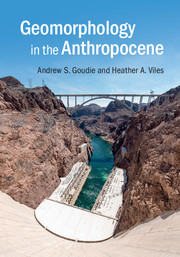Book contents
- Geomorphology in the Anthropocene
- Reviews
- Geomorphology in the Anthropocene
- Copyright page
- Contents
- Book part
- 1 Introduction to the Anthropocene and Anthropogeomorphology
- 2 Drivers of Anthropogeomorphological Change
- 3 Construction and Excavation
- 4 Subsidence in the Anthropocene
- 5 Weathering Processes in the Anthropocene
- 6 Hillslope Processes in the Anthropocene
- 7 Fluvial Processes and Forms in the Anthropocene
- 8 Aeolian Processes and Forms in the Anthropocene
- 9 Coastal Processes and Forms in the Anthropocene
- 10 Cryospheric Processes and Forms in the Anthropocene
- 11 Conclusions on the Relationships Between Geomorphology and the Anthropocene
- References
- Index
2 - Drivers of Anthropogeomorphological Change
Published online by Cambridge University Press: 20 October 2016
- Geomorphology in the Anthropocene
- Reviews
- Geomorphology in the Anthropocene
- Copyright page
- Contents
- Book part
- 1 Introduction to the Anthropocene and Anthropogeomorphology
- 2 Drivers of Anthropogeomorphological Change
- 3 Construction and Excavation
- 4 Subsidence in the Anthropocene
- 5 Weathering Processes in the Anthropocene
- 6 Hillslope Processes in the Anthropocene
- 7 Fluvial Processes and Forms in the Anthropocene
- 8 Aeolian Processes and Forms in the Anthropocene
- 9 Coastal Processes and Forms in the Anthropocene
- 10 Cryospheric Processes and Forms in the Anthropocene
- 11 Conclusions on the Relationships Between Geomorphology and the Anthropocene
- References
- Index
Summary
- Type
- Chapter
- Information
- Geomorphology in the Anthropocene , pp. 15 - 30Publisher: Cambridge University PressPrint publication year: 2016

